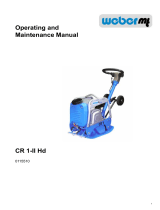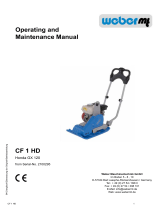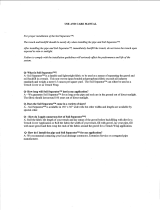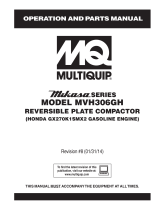Page is loading ...

CR 3-II Hd 1
CR 3-II Hd
Honda GX 270
0116144-00
Operating and
Maintenance Manual
0619 / englisch/Übersetzung der Original-Betriebsanleitung
Weber Maschinentechnik GmbH
Im Boden 5 – 8, 10
D-57334 Bad Laasphe-Rückershausen / Germany
Tel.: + 49 (0) 27 54 / 398 0
Fax: + 49 (0) 27 54 / 398 101
E-mail: [email protected]
Web: www.webermt.de

2 CR 3-II Hd

CR 3-II Hd 3
Table of contents
Introduction 4
Safety guidelines 5
Graphic presentation 9
Device description 10
Technical data 11
Activities prior to starting work 13
Starting 16
Compacting 17
Shutting down 18
Maintenance overview 19
Maintenance work 20
Operating uids and ll levels 22
Troubleshooting 24
Storage 23
Contact addresses 27

4 CR 3-II Hd
Introduction
This operating and maintenance manual is designed to facilitate familiarization with your soil compactor,
and to enable you to maintain the compactor and use it for its intended purpose.
When complying with the instructions in the operating and maintenance manual, you help avoid
hazards, reduce repair and downtime costs, and increase the reliability and service life of your soil
compactor.
This operating and maintenance manual must always be available at the implementation site of the
soil compactor.
If necessary, you can obtain additional information from your authorized WEBER MT dealer, or you
can obtain information from one of the contact addresses on the last page.
You can obtain information about the assembled HONDA gasoline engine and nd a spare-parts list
for it at www.honda-engines-eu.com
The valid conformity declaration is enclosed with every machine delivery.

CR 3-II Hd 5
Safety guidelines
General
All safety instructions must be read and complied with, as non-compliance will result in
– danger to life and limb of the user,
– impairments to the machine or other property.
In addition to the operating manual, the accident-prevention regulations in the country where the
appliance is used must be complied with.
Intended use
The soil compactor should only be used if it is in a technically faultless condition, as intended,
in a safety-conscious and hazard-conscious manner, and in compliance with the instructions in the
operating manual. Malfunctions that impair safety must be eliminated without delay.
The CR 3-II Hd soil compactor is designed exclusively for compacting
– sand,
– gravel,
– crushed rock,
– low-cohesive mixed material,
– concrete paving stone.
Any other use of the soil compactor is considered to be improper use for which the owner shall be
exclusively responsible. All liability is rejected if damage occurs due to non-compliance with this
provision. This risk is borne solely by the user.
Easily foreseeable misuse
Any use for which the machine is not intended.
Operation
Soil compactors are only permitted to be operated by suitable persons of or above the age of 18.
Personnel must be instructed in how to guide the compactor by the owner or by the owner’s assigned
personnel.
The machine operator must comply with trafc regulations. If instructions that affect safety are given
by third parties, then the operator must be authorized to reject these instructions.
Unauthorized persons are not allowed in the area of the soil compactor during the compacting
process.
Protective equipment
This machine is capable of exceeding the permissible sound level of 80 dB(A). The owner might also
face additional dangers when using the machine. Precautionary action must therefore be taken.
Protective equipment includes:
Hearing protection
Hard hat
Safety shoes
Protective gloves

6 CR 3-II Hd
Operation
Prior to starting work the owner of the compactor must be familiar with the work environment. The
work environment includes obstacles in the work and trafc area, the bearing capacity of the ground,
as well as the necessary safeguarding of the construction site in the area adjacent to public trafc;
and it includes compliance with trafc regulations.
The soil compactor should only be operated when the protective xtures are mounted.
The protective xtures must all be in functional condition.
At least once per shift the compactor must be checked for apparent defects. If there are apparent
defects then operation of the compactor must be stopped immediately, and the responsible person
must be informed. Prior to restarting, compactor malfunctions that have occurred must be corrected.
Always maintain adequate clearance to the edges of pits and embankments.
Do not drive at ninety degrees relative to the slopes to prevent the compactor from tipping over.
After work has been concluded secure the compactor in accordance with statutory regulations,
particularly in the area of public trafc surfaces.
Operation under difcult conditions
Never inhale the exhaust gas. It contains carbon monoxide, a colorless and odorless gas that
is extremely hazardous, which, if inhaled even briey, can cause unconsciousness and death.
Therefore, never operate the engines in enclosed areas or in areas that are poorly ventilated
(tunnels, caves, covered pits, etc.).
Be particularly cautious when operating the engine in the vicinity of people and livestock.
The soil compactor described in this operating manual is suitable for use in trenches that are
deeper than shoulder height, provided the following basic conditions have been met:
– trench width at least 1.5 m
– trench depth no more than 3.0 m
– open trench width at least 10 m
– slight wind movement in the trench
– the compactor is used for periods of no more than 4 x 15 minutes per shift, interrupted by breaks
(each approx. 1 hour)
If these basic conditions are not satised, the owner is required to implement the protective measures
identied as necessary to avoid CO poisoning during his own risk assessment. These may include:
– use of zero-emission compacting equipment
– blower-supported ventilation with a fan forcing air along the length of trench
The use of respiratory equipment during operation of this gasoline-powered compactor without docu-
mented evidence of conformity and without the necessary precautions is generally not permitted!
– as CO will accumulate in the blood after repeated use
– as CO lters have a short service life

CR 3-II Hd 7
Maintenance and repair work
Only use original Weber spare parts to ensure reliable and safe operation for maintenance or
repair tasks.
Hydraulic hose lines must be checked at regular intervals in accordance with standard engineering
practice, or they must be replaced at appropriate intervals, even if there are no signs of safety-relevant
defects.
Adjusting tasks, maintenance tasks, and inspection tasks must be carried out on schedule as
specied in this operating and maintenance manual. These activities should only be executed by
instructed personnel.
For repair, service, or inspection work, the engine of the compactor must be safeguarded against
unintentional starting.
All pressurized lines, particularly hydraulic lines and lines of the injection system of the drive motor
must be depressurized before performing maintenance or repair tasks.
For maintenance and repair tasks, the compactor must be parked on a level and stable substrate
and must be secured from rolling off or tipping over.
Heavy components and assemblies must be secured to and lifted by hoisting machines that can
bear their weight, when they are replaced. Ensure that no hazard is caused by raising components
or assemblies.
Do not position yourself or work under suspended loads.
If lubricating oils and fuel come into contact with skin, they can cause skin cancer. Upon contact
with the skin, clean affected skin with suitable cleaning agent without delay.

8 CR 3-II Hd
Warning against irritants or materials hazardous to health
Warning against a hazardous place
Warning against a suspended load
Wear ear protection
General regulation
Environmental protection
Hard hat
Safety shoes
Protective gloves
Inspection
Compactors must be inspected in accordance with the corresponding implementation conditions
and operating conditions, as needed; however an inspection to ensure operationally safe status
must be performed by an expert at least once a year. The results of the inspection must be recorded
in writing and must be stored at least until the next inspection.
Cleaning work
Prior to cleaning the compactor with a high-pressure cleaner, protect all accessible energized
switches, cable connections, etc. against water penetration by masking them off.
Cleaning tasks should only be executed in areas that are suitable and have been approved for this
purpose (oil separator amongst others).
Disposal
All operating uids and auxiliary materials must be disposed of in an environmentally compatible
manner in accordance with country-specic regulations.
Important information for operating and maintenance personnel is marked by pictograms.

CR 3-II Hd 9
1
3
4
6
2
4
5
7
8
9
10
Graphic presentation
1 Engine
2 Drive lever
3 Guide bar
4 Lifting ring
5 Base plate
6 Protective frame
7 Exciter
8 Gas lever
9 Attachment plates
10 Hearing protection (sticker)
Overall view CR 3-II Hd

10 CR 3-II Hd
Device description
The CR 3-II Hd soil compactor is used for road-building and landscaping compaction tasks.
Drive
The unit is powered by an air-cooled Honda gasoline engine.
Force is transferred to the exciter mechanically via a V-belt.
Operation
Start the Honda gasoline engine with the attached reversing starter.
After starting, vibration is switched on via the centrifugal clutch attached to the engine.
Use the gas lever to vary the engine speed between idle and full throttle.
Forward and reverse is variably controlled via the drive lever attached to the guide bar.

CR 3-II Hd 11
Technical data
CR 3-II Hd
Weight
Operating weight CECE in kg (basic device)
203
Dimensions
Overall length (in mm)
1350
Overall width / with attachment plates (in mm)
500/600/700
Height with folded guide bar (in mm)
1060
Base plate length (base in mm)
350
Pressure surface (in mm)
500 x 350
Drive
Engine manufacturer
Honda
Type
GX 270
Performance at operating speed in accordance
with ISO 3046-1 (kW)
5.1
Combustion process 4-stroke gasoline
Operating speed (1/min) 3000
Operating speed (ground-dependent in m/min) 20
Incline capacity (soil-dependent, in %) 35
Area capacity / with attachment plates (in m²/h) 585/702/819
Vibration
System Two-wave vibrator
Drive concept Mechanical
Frequency (in Hz) 80
Centrifugal force (in kN) 35
CR 3-II Hd
Noise emissions in accordance with 2000/14/EC
98
108
Sound pressure level L
PA
ascertained in accordance with EN 500, in dB (A)
Sound power level L
WA
ascertained in accordance
with EN ISO 3744 and EN 500, in dB (A)
Vibration values
2.0
Root-mean-square acceleration value for
hand-arm vibration ascertained in accordance
with EN 500 in m/s²
In accordance with directive 2006/42/EC,
complying with the vibration values is the
owner’s responsibility.

12 CR 3-II Hd
2
1
3 4
5
6
1 Description 2 TYPE
............................................................. .............................................................
3 Serial number 4 Year of construction
............................................................. .............................................................
5 Mass 6 Rated power kW
............................................................. .............................................................

CR 3-II Hd 13
3
1
2
5
4
7
6
Arrest the guide bar (1) with the holder (2).
Activities prior to starting work
Transporting
When transporting the soil compactor on a vehicle,
secure it with suitable restraints.
Fit the crane hook into the lifting ring (3) and lift the machine
onto the desired means of transport.
Only use lifting machines with a minimum bearing
capacity of 300 kg.
Do not step under suspended loads.
Transporting with undercarriage
Arrest the guide bar (4) with the holder (5).
Danger of tipping – pay attention to the machine weight.
Pull the locking pin (6) out of the holder and remove the
wheel (7).
Tilt the machine forward.

14 CR 3-II Hd
1
6
7
Fasten the wheel (7) on the base plate with
the locking pin (6).
Repeat the procedure for the second side.
Set the machine on the undercarriage.
Bring the guide bar into movement position and
arrest it with the movement safeguard (1).
Pay attention to the tire pressure of the undercarriage.
Tilt the machine to the rear and guide it via the
guide bar.

CR 3-II Hd 15
1
Adjusting the guide bar
Adjust the desired work height of the guide bar with the
set screw (1).
Checking the engine oil level
Unscrew and remove the oil dip stick from the crankcase.
The correct oil level is between the min. and max. marks.
Stop operating the engine immediately when the oil level
reaches the min. mark and top up oil until it reaches the
max. mark. Risk of engine damage if the oil level drops
below the minimum oil level in unfavorable operating
conditions.
Max.
Min.
Checking the fuel level
Open and remove the gas cap, check the level, if necessary
top up to the lower edge of the ller neck with clean fuel in
accordance with the specication.
For work at the fuel system, have a suitable re-extin-
guishing agent ready.
Fire, naked light, and smoking is forbidden!
UPPER LEVEL
LOWER LEVEL

16 CR 3-II Hd
1
2
3
5
4
Starting
Place the short-circuit button (3) in position 1.
Checking the hydraulic oil level
Check the hydraulic oil level when the machine is at operating
temperature. The guide bar must be in the transport position –
i.e. folded up. The correct oil level is reached when the oil is in
the middle of the view glass.
Mounting the attachment plates
Tighten the screws (1) of the attachment plates (2) with
a torque of 310 Nm.
Installing the protective mat
Fasten the protective mat with holder, screws, spring-lock
washers and nuts on the base plate front and rear.
Ensure that the protective mat rests under the base plate.
Slide the lever of the fuel cock (4) to the right.
Slide the choke lever (5) to the left (close).
After the engine has warmed up, slide the choke lever (5)
to the right (open).

CR 3-II Hd 17
2
1
4
3
Bring the gas lever into full-throttle position.
Slowly tighten the handle (1) of the reversing starter (2)
until resistance is noticeable.
Allow the handle (1) to slide back into the initial position,
and then forcefully and completely pull it all the way
through with both hands.
Allow the engine to warm up for a few minutes.
Compacting
Bring the gas lever (3) into full-throttle position.
Control drive speed and direction of travel with the handle (4).
Only run machine within reach of the guide bar.

18 CR 3-II Hd
1
2
3
Shutting down
Bring the gas lever (1) into idle position.
Move the fuel cock (2) to the left (close).
Place the short-circuit button (3) in position 0.
During breaks – even if they are short – the machine
must be shut down.
Parked devices that represent an obstacle must be
safeguarded via conspicuous measures.

CR 3-II Hd 19
Maintenance overview
Maintenance interval Maintenance point Maintenance activity
After the rst
25 operating hours
Engine – Change the engine oil
– Check valve play;
adjust if necessary
– Re-tighten all accessible
threaded connections
Every 8 operating
hours / daily
Air lter – Clean air lter insert,
check for damage,
replace if necessary
Every 150 operating
hours / every 6 months
Engine – Change the engine oil
– Change the fuel lter
– Change the oil lter
– Check the oil level
Gearshift
Every 150 operating
hours / every year
Gearshift – Change oil
– Change oil
Exciter
Every 250 operating
hours
Engine – Check valve play;
adjust if necessary
The regulations of the engine manufacturer must be complied with in addition to the above main-
tenance overview!
Tasks must be executed using proper tools, and the safety instructions of this operating and
maintenance manual must be complied with for all tasks.
All maintenance work: select collection vessels large enough to prevent oil from spilling onto the
ground. Dispose of waste oil in an environmentally friendly manner (regulation on waste oils).
Dispose of oils, greases, cloths soaked in oil, and replaced parts with oil on them in an environ-
mentally friendly manner.
If lubricating oils and fuel come into contact with skin, they can cause skin cancer. Upon contact
with the skin, clean affected skin with suitable cleaning agent without delay.
If accessible during maintenance, check the condition and stability of all screws.

20 CR 3-II Hd
2
3
1
Maintenance work
Changing the engine oil
Remove oil dip stick.
Screw the oil drain pipe (1) onto the drain valve and drain
the oil.
Only drain engine oil when at operating temperature.
After emptying completely, unscrew the oil drain pipe
from the drain valve and ll with oil in accordance with
the specication.
When working in the area of the engine compartment
there is danger of being burned!
Risk of scalding due to hot oil.
If lubricating oils and fuel come into contact with skin, they
can cause skin cancer. Upon contact with the skin, clean
affected skin with suitable cleaning agent without delay.
Dispose of oils, greases, cloths soaked in oil, and
replaced parts with oil on them in an environmentally
friendly manner.
Cleaning / changing air lter cartridge
Unscrew the air lter cover (2).
Remove the air lter insert from the air lter enclosure.
Clean air lter insert as specied by the engine manufacturer
if there is damage or if it is extremely dirty.
/











